The ARM vs x86 Wars Have Begun: In-Depth Power Analysis of Atom, Krait & Cortex A15
by Anand Lal Shimpi on January 4, 2013 7:32 AM EST- Posted in
- Tablets
- Intel
- Samsung
- Arm
- Cortex A15
- Smartphones
- Mobile
- SoCs
Krait: Idle Power
We'll start out our power investigation looking at behavior at idle. Although battery life when you're actually using your device is very important, having a fast SoC that can quickly complete tasks and race to sleep means that you need to be able to drive down to very low idle power levels to actually benefit from that performance. Here we're looking at power consumption at the Start Screen in Windows RT/8. You'll notice that there are two distinct periods during the benchmark, with the latter part of the graph showing lower power consumption thanks to the live tiles going to sleep. In this test, WiFi is enabled but there's no background syncing of anything. WiFi being on is why we continue to see power spikes even after the live tiles have gone to sleep:
The W510 does a great job of drawing little power at idle. Its silly WiFi implementation results in peak idle power consumption that's very similar to the Dell XPS 10, but the lowest the platform hits is appreciably lower than anything else. Surface RT remains the more power hungry of the three, while the XPS 10 falls somewhere in between MS and Acer.
If we isolate CPU core power alone though, things are a bit different. Keep in mind that we don't have the L2 power island instrumented, so the XPS 10 looks a little better than it should here but minimum CPU power consumption is very good on Krait. Although the Atom Z2760 is built on a special SoC derivative of Intel's 32nm process, I do suspect that it's not quite as low power as TSMC's 28nm LP. Things may change by the time 22nm rolls around however. All meaningful compute transistors here should be power gated, and what we end up looking at is the best case leakage for all SoCs. The Krait/28nm LP combination is awesome. I'm not sure why Tegra 3 is so much more active here towards the very end of the curve by comparison.
Adreno 225, or at least whatever Qualcomm drives off of the GPU power rail is extremely power efficient at idle. The PowerVR SGX 545 curve looks flatter at the end but Qualcomm is able to hit lower minimum power levels. It's not clear to me how much of this is architecture vs. process technology. On the GPU side there is some activity happening here as the display is still being refreshed even though the system is idle, so we're not looking at purely power gated consumption here.
To take the WiFi controller out of the equation, I tossed all tablets into Airplane mode and re-ran the same tests as above. You'll notice much less fluctuation in power consumption once the live tiles go to sleep.
Take WiFi out of the equation and Acer's W510 looks really good. Intel worked very hard with Acer to ensure power consumption was as low as possible on this device. The XPS 10 does a bit better than Surface RT here, but not tremendously so. Acer/Intel hold the clear advantage.
Looking at the CPU power island alone (excluding the L2 cache for Krait), we continue to see lower idle power consumption from APQ8060A vs. Atom Z2760. Once again I believe this is a TSMC 28nm LP advantage more than an architectural thing.


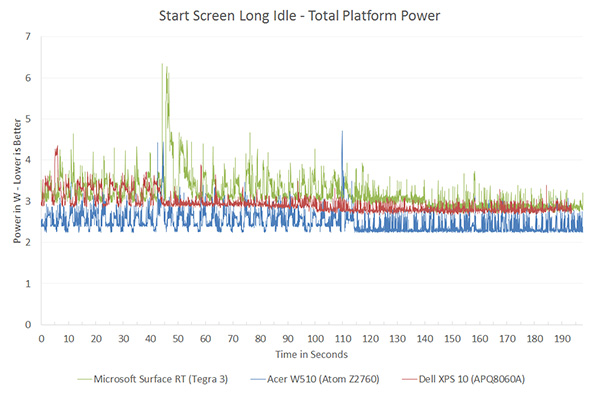
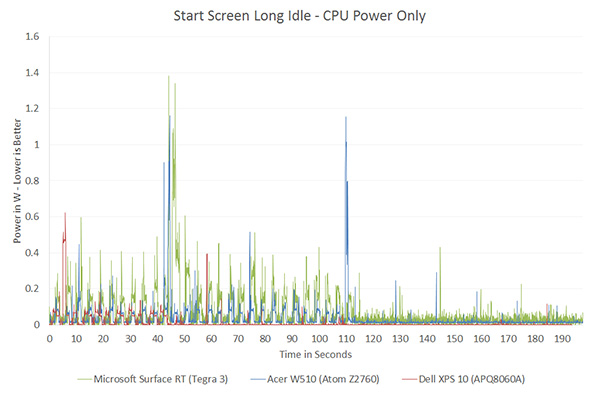
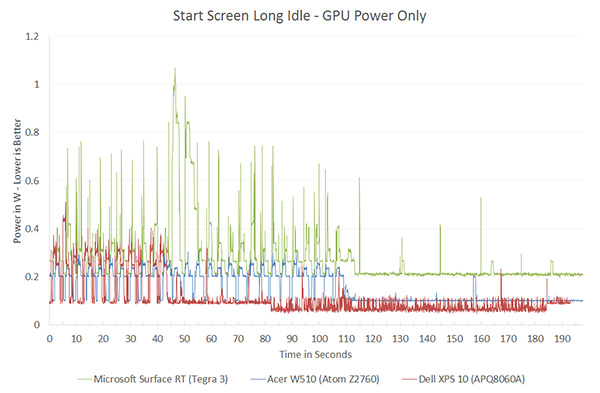
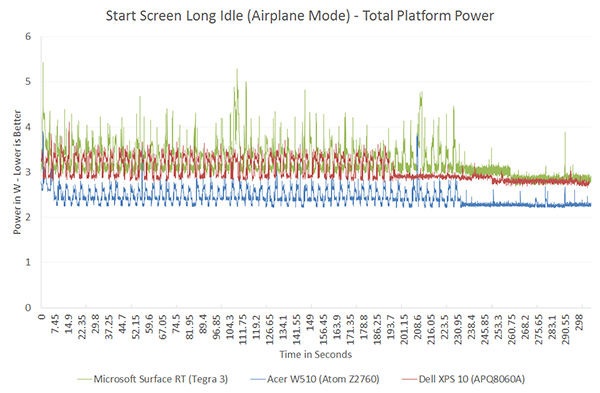
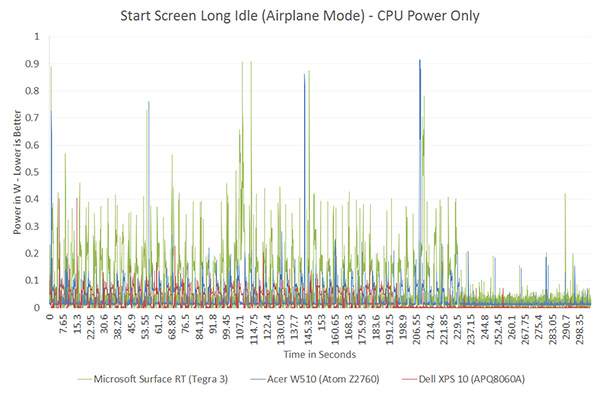
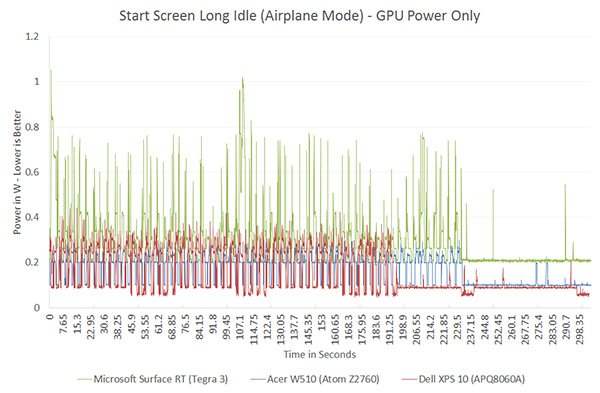








140 Comments
View All Comments
kyuu - Friday, January 4, 2013 - link
You're the one stepping into the past with the CISC vs. RISC. x86 is not going to go away anytime soon. Keep dreaming, though.iwod - Saturday, January 5, 2013 - link
Nothing about Architectures in this comment, but by the time ARM Cortex A57 is out, so is Intel ValleyView, which doubles the performance. A57 is expected to give in best case scenario 30 - 50% increase in performance. And All of a sudden this look so similar to 2x Atom performance.It will only take one, just ONE mistake that ARM make for Intel to possibly wipe them off the map.
Although looking into the next 3 - 5 years ahead. It will be a bloody battle instead.
Cold Fussion - Friday, January 4, 2013 - link
Why didn't have any charts which were performance per watt or energy consumption vs performance in the GPU area? If the Mali chip is using twice the energy but giving 3x the performance then that is a very significant point thats being misrepresented.mrdude - Friday, January 4, 2013 - link
I was thinking the same thing.If I can game at native resolution on a Nexus 10 at better frame rates than on the Atom or Snapdragon SoC and the battery capacity is larger and the price of the device is equal, then do I really care about the battery life?
Although it's nice seeing Intel is getting x86 down to a competitive level with ARM, the most astonishing thing that I took away from that review was just how amazing that MaliT604 GPU is. All that performance and only that power draw? Yesplz :P
parkpy - Friday, January 4, 2013 - link
i've learned so much from AT's review of the iPhone5, Galaxy S III, and Nexus 4, and this article about mobile phones that it makes me wish AT could produce MORE reviews of mobile devices.All of this information is crack! I can't get enough of it. Keep up the good work! And Intel, I can't wait for you to get your baseband processor situation sorted out!
I was already tempted to get a Razr I, but it looks like before the end of the year consumers will have some very awesome technology in their phones that won't require as much time on the battery charger!
This Guy - Friday, January 4, 2013 - link
What if Rosepoint is software defined instead of fixed function?ddriver - Friday, January 4, 2013 - link
I am confused here - this review shows the atom to be somewhat faster than A15, while the review at phoronix shows the A15 destroying the atom, despite the fact intel's compiler is incredibly good at optimizations and incomparably more mature.So I am in a dilemma on who to trust - a website that is known to be generously sponsored by intel or a website that is heavily focused on open source.
What do you think?
kyuu - Friday, January 4, 2013 - link
Uh, did we read the same article? Where does it show the Atom being "somewhat faster than A15"? The article showed that the A15 is faster than Atom, but at a large power premium.ddriver - Friday, January 4, 2013 - link
On the charts I see the blue line ending its task first and taking less time, blue is atom, right?jwcalla - Friday, January 4, 2013 - link
A couple things:1) The Phoronix benchmarks were for different Atoms than the one used in this article. I don't know how they compare, but they're probably older models.
2) The Phoronix benchmarks used GCC 4.6 across the board. Yes, in general GCC will have better optimizations for x86, but we don't know anything (unless I missed it) about which compilers were used here. If this was an Intel sample sent to Anand, I'm sure they compiled the software stack with one of their own proprietary Intel compilers. Or perhaps it is the MS compiler, which no doubt has decades of x86 optimizations built in and probably less ARM work than GCC (for the RT comparison).
Don't take the benchmarks too seriously, especially since even the software isn't held constant here like it was in the Phoronix benchmarks. It's all ballpark information. Atom is competitive with ARMv7 architectures -- that's the takeaway.